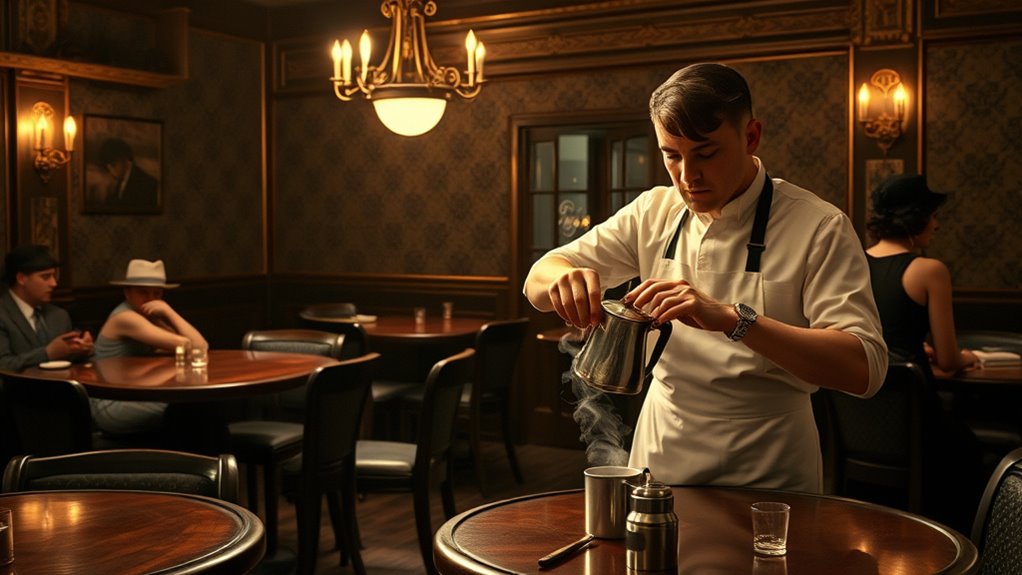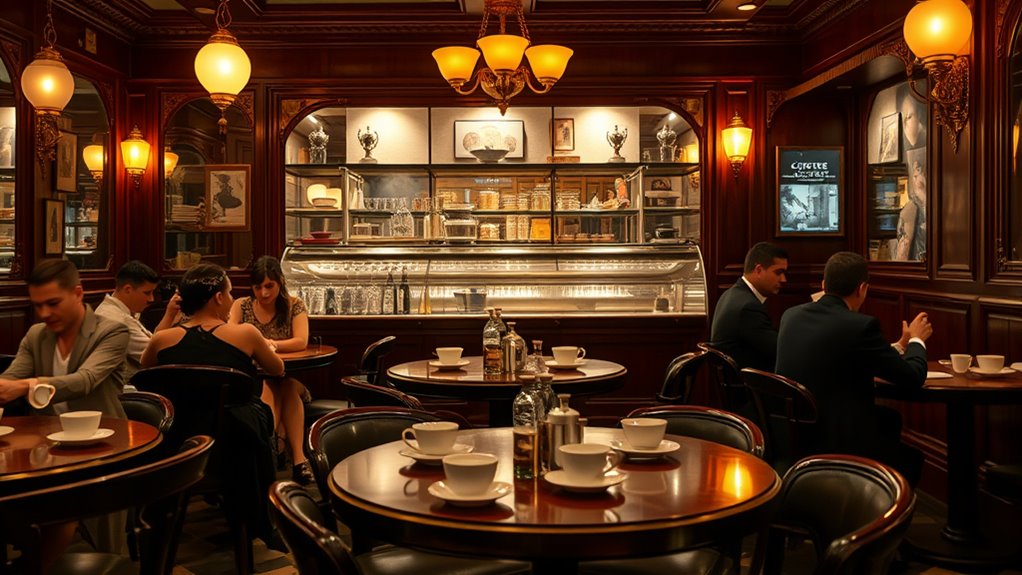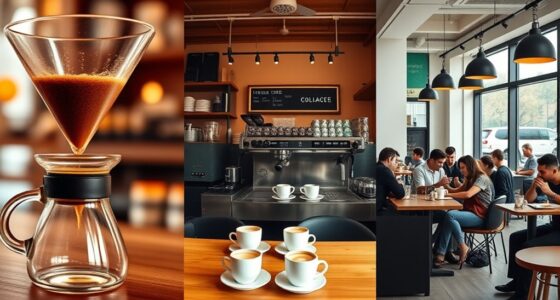During Prohibition, coffeehouses became secret refuges, replacing speakeasies by offering a discreet space to socialize and carry out clandestine activities. They operated under the guise of cafes, serving hot coffee while secretly supporting underground gatherings. Organized crime and bootleggers used these venues to maintain their networks. These vintage coffeehouses offered a sense of normalcy amid chaos, hiding secret meetings behind unassuming facades. To learn how these covert spots evolved into cultural symbols, keep exploring their fascinating history.
Key Takeaways
- During Prohibition, coffeehouses served as discreet refuges, offering a legal alternative to illegal speakeasies.
- Vintage coffeehouses often concealed secret activities like bootlegging, blending social gathering with clandestine operations.
- Coffee shops became central to social life, providing a relaxed environment with jazz music, discussions, and news.
- These cafes symbolized resilience, turning laws into opportunities for community bonding and covert exchanges.
- Over time, the unassuming coffeehouse culture replaced the speakeasy, normalizing coffee as a staple of social and cultural life.

Have you ever wondered how coffee shops thrived during Prohibition? During this period, when alcohol was banned, many entrepreneurs and ordinary folks found inventive ways to keep their social lives alive. One of the most interesting adaptations was the rise of vintage coffeehouses, which served as quiet refuges from the clandestine world of speakeasies. These cozy establishments often operated under the guise of cafes, offering hot coffee and a sense of normalcy while secretly catering to those seeking a spirited thrill. The bootlegging history of the era played a significant role in shaping this shift. As illegal alcohol trade flourished, many bootleggers and organized crime figures sought to diversify their operations. Some moved into the coffee business, transforming their illegal enterprises into seemingly legitimate ventures. They supplied these vintage coffeehouses with coffee beans and equipment, establishing a network that kept the spirit of social gathering alive, even if alcohol was out of reach.
The rise of these coffee-centric venues wasn’t accidental. They became an essential part of the social fabric, providing a safe space for conversation, business deals, and community bonding. Unlike the secretive, tense atmosphere of speakeasies, vintage coffeehouses promoted a more relaxed, open environment. They often featured jazz music, lively discussions, and the latest news, making them lively hubs for urban life. Many of these establishments also doubled as hubs for the underground economy, where patrons could discreetly exchange information or even smuggle small amounts of alcohol in coffee mugs or hidden compartments. This blending of commerce and clandestine activity helped keep the spirit of rebellion alive, even as Prohibition aimed to suppress it. Additionally, this era saw a cultural shift in the way people viewed coffee. It became more than just a morning pick-me-up; it symbolized resilience and adaptability. As law enforcement cracked down on illegal alcohol, the need for discreet social spaces grew. Vintage coffeehouses became the perfect cover, their unassuming facades hiding a world of secret meetings and bootlegging connections. To the outside observer, they appeared as simple cafes, but inside, they pulsed with the energy of defiance and ingenuity. Their popularity persisted because they offered a sense of community and normalcy amid chaos. Over time, these coffeehouses contributed to the eventual normalization of coffee culture, paving the way for the modern cafés we enjoy today. So, in a way, the history of bootlegging and vintage coffeehouses during Prohibition demonstrates how people’s resourcefulness can turn even the harshest laws into opportunities for innovation and community building. [This resourcefulness was often fueled by the need for discreet communication methods to coordinate illegal activities.
Frequently Asked Questions
How Did Coffee Culture Change During Prohibition?
During prohibition, you notice coffee culture shifts as people seek alternative social spots. Coffee brewing innovations improve your experience, making beverages more flavorful and accessible. Underground coffee networks develop, allowing you to enjoy quality coffee discreetly, replacing speakeasies. These hidden cafes become social hubs where you can connect safely, fueling a quiet rebellion against prohibition restrictions. Coffee therefore transforms into a symbol of resilience and social interaction during this challenging era.
Were There Specific Coffee Blends Popular in Speakeasies?
You might think speakeasies only served alcohol, but they also featured secret coffee recipes. During that time, unique blends with specific coffee bean varieties gained popularity, creating a clandestine caffeine culture. These blends often had secret ingredients, making them exclusive. While no single blend defined the era, the emphasis on secret recipes and special beans highlights how coffee became an underground symbol of rebellion and sophistication.
Did Prohibition Influence Coffeehouse Architecture or Design?
You’ll notice that prohibition influenced coffeehouse aesthetics and clandestine design, making them more discreet and inviting. You might see hidden entrances, cozy corners, and subtle decor that foster a sense of secrecy. These design choices helped create a welcoming atmosphere while maintaining privacy. As a result, coffeehouses became more than just places to drink—they evolved into social hubs that subtly blended safety and style during challenging times.
How Did Coffee Consumption Impact Prohibition-Era Social Dynamics?
You find that coffee consumption during Prohibition shifted social dynamics by fostering more open, accessible gatherings outside secretive speakeasies. Unlike cocktail culture, which thrived in hidden venues, coffeehouses encouraged casual socialization and community bonding. You notice that as coffee became more popular, it helped replace the clandestine speakeasy scene, making social interactions more transparent and widespread, ultimately shaping a more inclusive and relaxed atmosphere amid challenging times.
Were There Any Famous Figures Associated With Prohibition-Era Coffee Scenes?
Imagine famous figures shaping the prohibition-era coffee scene, inspiring curiosity and innovation. You see them blending coffee financials with brewing innovations, fueling social change. Notable personalities like Elizabeth C. Price or clandestine café owners became symbols of resilience, turning coffee into a symbol of rebellion. Their stories evoke emotion, showing how these figures transformed quiet moments into acts of defiance, shaping a vibrant cultural shift through bold brews and clever finance.
Conclusion
Just as a phoenix rises from ashes, the café emerges from the shadows of Prohibition, transforming secrecy into social sanctuary. What once hid behind hidden doors now welcomes you openly, a symbol of resilience and rebirth. As you sip your coffee, remember that even in the darkest times, hope brews anew—proof that from the ashes of restriction, a new world of flavor and connection can flourish. Your journey is part of that enduring cycle.









